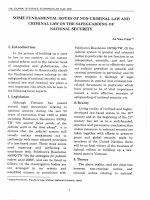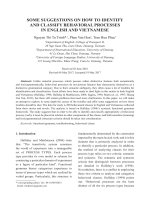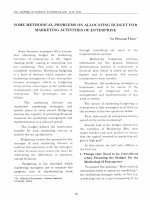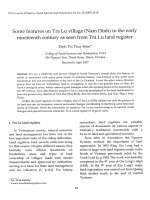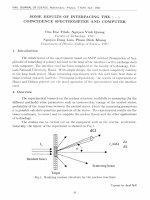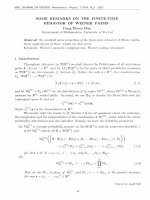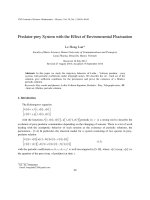DSpace at VNU: Some recommendations to develop the market share, the case of ILA Vietnam in Hanoi
Bạn đang xem bản rút gọn của tài liệu. Xem và tải ngay bản đầy đủ của tài liệu tại đây (136.26 KB, 5 trang )
Some recommendations to develop the market
share, the case of ILA Vietnam in Hanoi
Trần Thùy Linh
Khoa Quản trị Kinh doanh
Luận văn Thạc sĩ ngành: Quản trị kinh doanh; Mã số: 60 34 05
Người hướng dẫn:
Năm bảo vệ: 2011
Abstract. Among 6.9 billion population of the world, English is used as day to day
communication in which: 400 million native speakers, 700 million non-native
speakers, 1 billion people who are studying English in the world today. Over US \1 5
billion was spent in the English Language Training industry year 2007 (lessons,
books, exams, etc). 80% of all of the information stored in the world‟s computers is
in English. Over 50% of the world‟s scientific journals [reports, books, etc] are in
English. 80% of the English used today is between non-native English speakers.
These facts and figures showed the importance and development of English
Language Training industry. English has become a most popular and an international
language. It is used over the world and is an official language in most of important
organizations as the United Nation, World Trade Organization, International
Monetary Bank, World Bank…Vietnam joined WTO and is member of others
organizations so English has become more important than ever. In the era of culture
and trade exchange, consumer behaviour of people changed a lot. In learning
English, people changed from Vietnamese teacher to native teacher. The method of
studying has changed from reading and writing to practicing speaking and listening.
The reason is that English is not only used in documents andacademic studying but
also in daily using. The companies have to understand the trend and consumer
buying process to deliver the suitable marketing strategy. Customer should be the
starting point of every marketing strategy. ILA is a famous brand name in
Hochiminh City about quality English Language trainer. There were more than
30,000 people studied at ILA each year in nation wide. There were 8 branches in
Hochiminh City, one in Vungtau, one in Danang and one in Hanoi. Even the
company used same marketing strategy that was successful in Hochiminh city; ILA
Vietnam in Hanoi still had negative profit since it grand opening in 2007. The
company did not understand customers‟ demands in Hanoi then applied unsuitable
marketing mix. In order to gain the market share development, ILA has to change a
more suitable marketing mix for ILA Hanoi. The thesis would like to analyze the
problems of applying unsutable marketing mix in Hanoi and recommend some
marketing solutions to improve company‟s market share. Due to limitation of
ability, the solutions may concentrate on Marketing activities and strategies.
Keywords. Tiếp thị; Thị phần; Quản trị kinh doanh
Content
TABLE OF CONTENTS
ACKNOWLEDGEMENTS .................................................................................................... i
ABSTRACT ........................................................................................................................... ii
TÓM TẮT............................................................................................................................. iv
TABLE OF CONTENTS ..................................................................................................... vi
LIST OF FIGURE ............................................................................................................ viii
LIST OF TABLE .................................................................................................................. ix
INTRODUCTION ................................................................................................................. 1
1. Research Problem .......................................................................................................... 1
2. Objective and aim of thesis ............................................................................................ 1
3. Scope and scale of thesis ............................................................................................... 2
4. Methodology .................................................................................................................. 2
5. Data resources ................................................................................................................ 2
CHAPTER 1: LITERATURE REVIEW ............................................................................... 4
1.1
1.1.1.
Market share........................................................................................................... 4
Definition ........................................................................................................... 4
1.1.2 Ways to increase market share .............................................................................. 5
1.2. Consumer decision making process ............................................................................ 6
1.2.1 Information search ................................................................................................. 6
1.2.2 Source of information ............................................................................................ 8
1.2.3 Information search on the Internet ......................................................................... 9
1.3. Customer Value, Satisfaction, and Loyalty .............................................................. 13
1.3.1. Customer Value ................................................................................................... 14
1.3.2. Total Customer Satisfaction ................................................................................. 17
1.3.2.1. Customer expectation ...................................................................................... 18
1.3.2.2. Measuring Satisfaction .................................................................................... 18
1.4. Marketing mix ........................................................................................................... 19
1.4.1
The product .......................................................................................................... 19
1.4.2 Promotion mix.......................................................................................................... 27
1.4.2.1 Advertising ...................................................................................................... 28
1.4.2.2 Sales promotion ............................................................................................... 31
1.4.2.3 Public relation ................................................................................................... 33
1.4.3Place .......................................................................................................................... 34
1.4.4Price .......................................................................................................................... 39
CHAPTER 2: THE CASE OF ILA VIETNAM IN HANOI............................................... 41
2.1 Introduction ............................................................................................................... 41
2.2. Business analysis ...................................................................................................... 44
2.2.1. Analysis of visitor and sources of information channel ...................................... 44
2.2.3. Product analysis and comparison ......................................................................... 47
2.2.3. New sales analysis ............................................................................................... 55
2.2.4. Re-enrolment and customers’ loyalty analysis .................................................... 57
2.2.5 Promotion mix analysis ....................................................................................... 58
2.2.6. Place.................................................................................................................... 63
CHAPTER 3: CONCLUSION AND RECOMMENDATIONS ......................................... 67
3.1 Conclusion ................................................................................................................ 67
3.2 Recommendations ..................................................................................................... 69
3.2.1 The information search on the Internet ................................................................ 69
3.2.2 Building Customer Value, Satisfaction, and Loyalty .......................................... 70
3.2.3. Marketing mix...................................................................................................... 73
3.3. Product ................................................................................................................... 73
3.4. Promotion mix ....................................................................................................... 77
3.5. Place....................................................................................................................... 81
REFERENCES ....................................................................................................................83
Appendix ..............................................................................................................................85
References
Aaker, D. A., Kumar, V., & Day, G. S. (2003). Marketing Research. Hoboken, New Jersey:
John Wiley & Sons.
Best, Hawkins, Coney (2004); “Consumer Behaviour”, 9th edition, McGraw- Hill
Companies, Inc, USA
Bryman, A. & Bell, E. (2007). Business Research Methods. Oxford University Press Inc.,
New York.
Danziger, Pamela N., 2004: Why People Buy Things They Don’t Need: Understanding and
Predicting Consumer Behavior. Dearborn Trade Publishing.
Dichter, Ernest, 1964: Handbook of Consumer Motivations. New York
Donald. R. Cooper & Pamela S. Schindler - Business Research Methods, 8th Edition,
McGraw-Hill Companies, Inc, USA, 2003
Engel, J.F., Blackwell, R.D., & Miniard P.W. (1995). Consumer Behavior, 8th ed., Forth
Worth, T.X.Dryden Press.
Evans, M., Jamal, A. & Foxall, G. (2006). Consumer Behavior, p.59-60,189.
Grossack, Martin M.,
1964: Understanding Consumer Behavior. The
Christopher Publishing House, Boston, U.S.A.
ILA competitor’s reports.
ILA customer visits report -2008, 2009, 2010.
ILA sales report - 2009, 2010.
Kotler, P. & Armstrong, G. (2005). Principles of Marketing: Marketing managing profitable
customer relationships: Marketing defied. China: Tsinghua University.
Kotler, P., Wong, V., Saunders, J., & Armstrong, G. (2005). Principles of Marketing. (4th
European Ed.). Harlow: Pearson Education
Michael R. Solomon (2003), Consumer Behavior, 6th edition, Upper Saddle River, N.J.:
Pearson Prentice Hall.
Moroko and Uncles, Employer branding and market segmentation, 2009
Peter, J.P., & Olson, J.C. (2008). Consumer Behaviour and Marketing Strategy (8th Ed.).
New York: McGraw-Hill Education
Philip Kotler, Kevin Lane Keller, Marketing Management 12th Edition, Pearson Education,
Prentice Hall, USA, 2006
Solomon, M. R. (2004). Consumer behaviour: Buying, having and being. (6th Ed.). Upper
Saddle River, New Jersey: Pearson Education
Solomon, M., Bamossy, G., Askegaard, S. and Hogg, M.K. (2007), Consumer Behavior: A
European Perspective, 3rd ed., Upper Saddle River: Pearson Prentice Hall.
Souiden N., Kassim N. M. and Hong H-J. (2006), The effect of corporate branding
dimensions on consumers product evaluation: A cross-cultural analysis, European Journal of
Marketing, Vol. 40 No. 7/8, p. 825-845.
Vietnam Economic Times, 1, 2, 3, 4, 5, 6- 2010.

